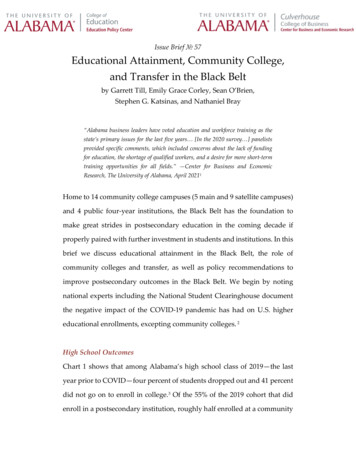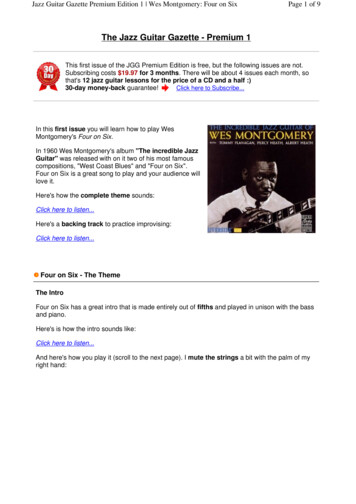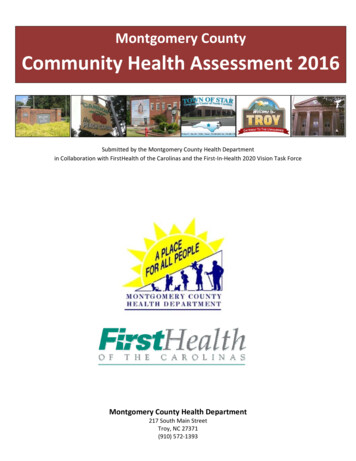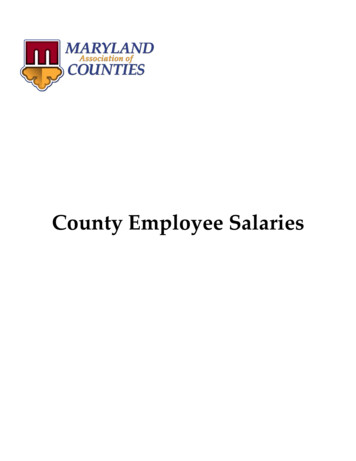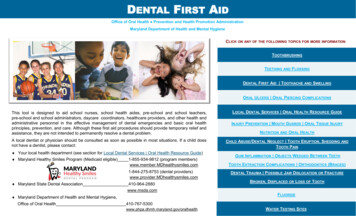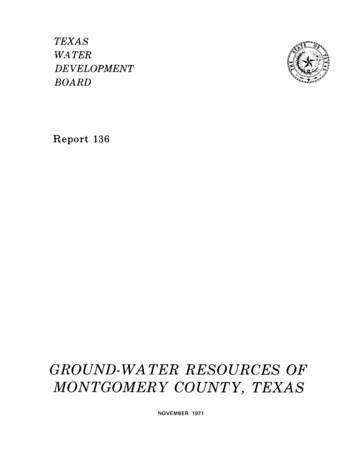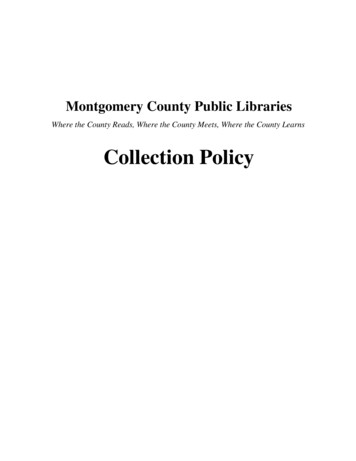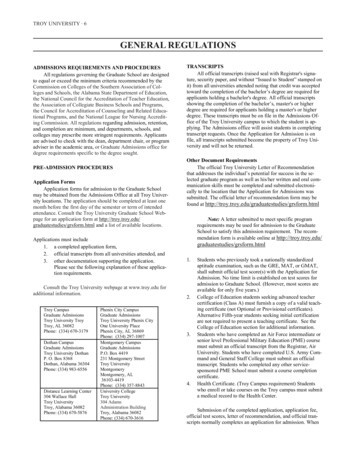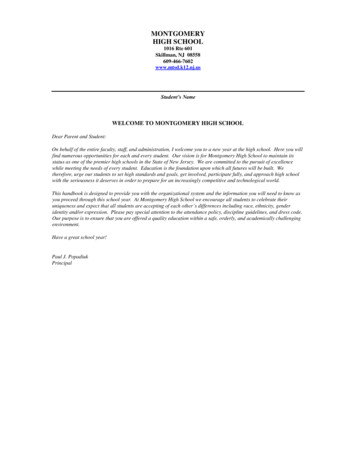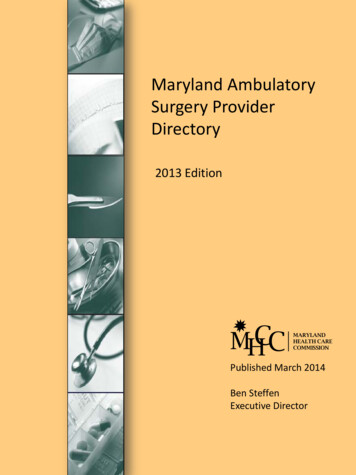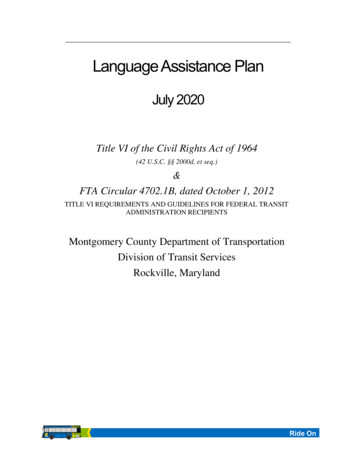
Transcription
CONTINUED ON BACKLanguage Assistance PlanJuly 2020Title VI of the Civil Rights Act of 1964(42 U.S.C. §§ 2000d, et seq.)&FTA Circular 4702.1B, dated October 1, 2012TITLE VI REQUIREMENTS AND GUIDELINES FOR FEDERAL TRANSITADMINISTRATION RECIPIENTSMontgomery County Department of TransportationDivision of Transit ServicesRockville, MarylandRide On
Language Assistance PlanJuly 2020Accessible FormatsThis document will be made available in accessible formats upon request. Paper copies of thisdocument as well as information regarding accessible formats may be obtained by contacting theTitle VI Coordinator, Division of Transit Services.This notice will be made available in other languages.Este aviso estará disponible en otros ��提供ChineseCet avis seront disponible dans d'autres langues.이 통지는 다른 언어에서 사용할 수 있는 만들 것 이다.Thông báo này sẽ được thực hiện có sẵn trong các ngôn ngữ khác.FrenchKoreanVietnameseMontgomery County Department of TransportationDivision of Transit Services101 Monroe Street, 5th FloorRockville, Maryland 20850RIDE ONii
Language Assistance PlanJuly 2020ContentsI.Background . 1II.Identification of LEP Individuals Who Need Language Assistance . 3III.Frequency of Contact by LEP Persons with Ride On Services . 13a.b.c.d.IV.Call Center – Requests for Interpretation . 13Website Data Translations . 13On-board Survey . 13Montgomery County Ride On Reported Data . 13Nature and Importance of Transit . 14V.Available Resources & Costs of Providing Language Assistance Services 14VI.Language Assistance Measures Employed by Montgomery County . 15VII.Planned Language Assistance Initiatives . 17RIDE ONiii
I.BackgroundTitle VI of the Civil Rights Act of 1964, 42 U.S.C. 2000d et seq., provides that no person in the UnitedStates shall, on the grounds of race, color, or national origin, be excluded from participation in, be deniedthe benefits of, or be otherwise subjected to discrimination under any program or activity that receivesFederal financial assistance. The Supreme Court, in Lau v. Nichols, 414 U.S. 563 (1974), interpreted TitleVI regulations promulgated by the former Department of Health, Education, and Welfare to hold that TitleVI prohibits conduct that has a disproportionate effect on Limited English Proficient (LEP) persons becausesuch conduct constitutes national origin discrimination.Executive Order 13166, “Improving Access to Services for Persons with Limited English Proficiency,”reprinted at 65 FR 50121, August 16, 2000 directs each Federal agency to examine the services it providesand develop and implement a system by which LEP persons can meaningfully access those services. Federalagencies were instructed to publish guidance for their respective recipients in order to assist them with theirobligations to LEP persons under Title VI. The Executive Order states that recipients must take reasonablesteps to ensure meaningful access to their programs and activities by LEP persons.President Bush affirmed his commitment to Executive Order 13166 through a memorandum issued onOctober 25, 2001 by Assistant Attorney General for Civil Rights, Ralph F. Boyd, Jr. Federal agencies weredirected to provide guidance and technical assistance to recipients of Federal funds as to how they canprovide meaningful access to Limited English Proficient users of Federal programs.The U.S. DOT published revised guidance for its recipients on December 14, 2005. This document statesthat Title VI and its implementing regulations require that DOT recipients take responsible steps to ensuremeaningful access to the benefits, services, information, and other important portions of their programs andactivities for individuals who are Limited English Proficient (LEP) and that recipients should use the DOTLEP Guidance to determine how best to comply with statutory and regulatory obligations to providemeaningful access to the benefits, services, information, and other important portions of their programs andactivities for individuals who are LEP.The Federal Transit Administration (FTA) references the DOT LEP guidance in its Circular 4702.1B, “TitleVI Requirements and Guidelines for Federal Transit Administration Recipients,” which was published onOctober 1, 2012. Chapter III, section 9 of this Circular reiterates the requirement to take responsible stepsto ensure meaningful access to benefits, services, and information for LEP persons and requires that FTArecipients and sub-recipients develop a language implementation plan consistent with the provisions of theDOT LEP Guidance.The DOT LEP Guidance recommends that all recipients, especially those that serve large LEP populations,should develop an implementation plan to address the needs of the LEP populations they serve. The DOTLEP Guidance notes that effective implementation plans typically include the following five elements: 1)identifying LEP individuals who need language assistance; 2) providing language assistance measures; 3)training staff; 4) providing notice to LEP persons; and 5) monitoring and updating the plan.Individuals, who have a limited ability to read, write, speak, or understand English are Limited EnglishProficient, or ‘‘LEP.” Transit agencies that provide language assistance to persons with Limited EnglishProficiency in a competent and effective manner will help ensure that their services are safe, reliable,convenient, and accessible to those persons. These efforts may attract riders who would otherwise beexcluded from participating in the service because of language barriers and, ideally, will encourage ridersto continue using the system after they are proficient in English and/or have more transportation options.RIDE ON1
Catering to LEP persons may also help increase and retain ridership among the agency’s broader immigrantcommunities in two important ways: 1) agencies that reach out to recent immigrant populations in order toconduct a needs assessment and prepare a language implementation plan (pursuant to the DOT LEPGuidance) will send a positive message to these persons that their business is valued; and 2) communityoutreach designed to identify appropriate language assistance measures can also assist the agency inidentifying the transportation needs of immigrant and linguistically isolated populations and ensuring thatan agency’s transit routes, hours and days of service, and other service parameters are responsive to theneeds of these populations. Additionally, transit agencies that conduct outreach to LEP persons can increasetheir potential for recruiting bilingual employees to better serve the needs of the community. In summary,serving the needs of LEP persons is not only a good business decision; it fulfills the mission of the transitagency to serve the public.Montgomery County is a very diverse county with more than 39 different languages spoken. TheMontgomery County Department of Transportation (MCDOT) supports the goals of the DOT LEPGuidance to provide meaningful access to its services by LEP persons. Montgomery County has devotedsignificant resources to provide oral and written language assistance services to LEP individuals.This document provides Ride On’s 2020 Language Assistance Plan and includes:1.2.3.4.5.Identification of LEP Individuals in Montgomery County Who Need Language AssistanceThe Nature and Importance of Transit to LEP IndividualsAvailable Resources and Costs of Providing Language Assistance ServicesLanguage assistance measures employed by Montgomery CountyPlanned language initiativesRIDE ON2
Identification of LEP Individuals Who Need LanguageAssistanceII.The United States Census’ most recent American Community Survey (ACS) 5-year estimates(2013-2018) and 2018 one-year estimate offer current and reliable estimates of the number,proportion, and geographic distribution of LEP persons in the Ride On service area. This analysisof LEP individuals uses data estimates for the “county subdivision” census-defined areas (shownin Figure 1). The county subdivision geography was chosen because the estimates at this levelprovide the best balance between detail and statistical significance of the data.According to the ACS 2018 one-year estimate, of the total Montgomery County population overthe age of five (986,740), approximately 14.3% (140,833) speak English less than “very well”.Spanish/Spanish Creole, Chinese, African languages, Korean, French (including Patois and Cajun)and Vietnamese, speakers make up the majority (approximately 80%) of the languages spoken athome among the subpopulation of people 5 years and over who speak English less than “verywell.” Table 1 shows the number and proportion of all languages spoken using the AmericanCommunity Survey 2018 one-year data1.The Spanish speaking population has the largest number of persons (68,541) within the countywho speak English less than “very well” with Chinese speakers having the second largest segment(16,836 persons) who speak English less than “very well.”Figure 1, shows that the highest concentrations of linguistically isolated households2 are locatedin and around the Germantown/Gaithersburg area in the center of the county and the WheatonGlenmont/College Park area just north of Washington, D.C.1ACS 1 yr Table B08113: LANGUAGE SPOKEN AT HOME BY ABILITY TO SPEAK ENGLISH FOR THEPOPULATION 5 YEARS AND OVER.2households where no person age 14 or older in the household speaks English only or speaks English “very well”.RIDE ON3
Figure 1: Percent Linguistically Isolated Households, Montgomery CountyRIDE ON4
Table 1: Language Spoken at Home of Persons that Speak English Less than "Very Well" inMontgomery County (Population 5 Years and Over)Montgomery CountyNumber ofLEPPopulation68,54116,836LanguageSpanishChinese (incl. Mandarin, Cantonese)Amharic, Somali, or other Afro-Asiaticlanguages6,881Korean6,131French ,028Bengali2,518Persian (incl. Farsi, Dari)2,117Tagalog (incl. Filipino)2,030Swahili or other languages of Central, Eastern,and Southern Africa1,844Nepali, Marathi, or other Indic languages1,417Urdu1,274Japanese1,226Yoruba, Twi, Igbo, or other languages ofWestern Africa1,108Haitian1,037Gujarati1,009Ilocano, Samoan, Hawaiian, or otherAustronesian languages1,006Other Slavic languages994Hindi979Arabic964Other languages of Asia951Thai, Lao, or other Tai-Kadai languages878Tamil576Other and unspecified languages551Malayalam, Kannada, or other Dravidianlanguages536Other Indo-European 29Total LEP Population140,833Total County Population986,740Source: American Community Survey 2018 1-year estimatePercent ofCountyPopulationSpeakingLanguage6.9%1.7%Percent %0.2%0.2%0.2%0.1%0.1%0.1%0.1%0.0%100.00%RIDE ON5
Using American Community Survey 5-year Estimates2013 – 2018, Figures 2 – 7 (pages 6-8) help identifywhere the highest concentration of each of the top sixlanguages of LEP persons (Spanish/Spanish Creole,Chinese, Korean, African languages, Vietnamese, andFrench (including Patois and Cajun)) are spoken. Thefigures show the percent of the population of each countysubdivision that speaks the given language at home andspeaks English less than “very well”. Those subdivisionsshown in red have the greatest percentage of thepopulation with limited English proficiency that speaksthe given language. These figures give reasonableguidance regarding the areas likely to have higherlanguage assistance needs and for which languages theassistance is needed; we can be confident that thosecounty subdivisions shown in red tones have higherconcentrations of the given LEP population than thosecounty subdivisions in green, but the rankings amongsubdivisions that have closer percentages may not holdtrue in reality. 3FTA Safe Harbor Guidance:“Safe harbor” for translation ofwritten material“Safe Harbor” stipulates if arecipient provides writtentranslation of vital documents foreach eligible LEP language groupthat constitutes 5% or 1,000persons, whichever is less, of thetotal population of persons eligibleto be served or likely to be affectedor encountered, then such actionwill be considered strong evidenceof compliance with the recipient’swritten translation ot.gov/files/docs/Title VI Overview 4702.1B 11.05.12 ER.pdf3Note regarding data limitations: This calculation deals with some sub-populations that are small and in some casesthe estimates come with a significant margin of error; therefore, the percentages presented in Figures 2-7 can beconsidered good enough to identify the areas with highest percentages of LEP, non-English speakers, butpercentages should not be used as concrete figures to compare with other data.RIDE ON6
Figure 2: Spanish Speakers with Limited English Proficiency (percent of population by county subdivision)RIDE ON7
Figure 3: Chinese Speakers with Limited English Proficiency (percent of population by county subdivision)RIDE ON8
Figure 4: Korean Speakers with Limited English Proficiency (percent of population by county subdivision)RIDE ON9
Figure 5: African Language Speakers with Limited English Proficiency (percent of population by countysubdivision)RIDE ON10
Figure 6: Vietnamese Speakers with Limited English Proficiency (percent of population by countysubdivision)RIDE ON11
Figure 7: French Speakers (including Patois, Cajun) with Limited English Proficiency (percent of populationby county subdivision)American Community Survey 2018 one-year estimates on workers 16 years and over is shown inTable 2.Table 2: Workers 16 years and OverMontgomery CountyOnly EnglishSpanish SpeakersOther LanguagesSpeak English less than “very well”Spanish Speakers less than “very well”Other Languages less than “very well”Source: ACS 2018 1-year Table 64442,395% of workers100.0%56.2%17.8%26.0%15.3%7.7%7.5%Table 3 presents 2018 mode of transportation estimates. Of Montgomery County’s estimated563,495 workers 16 years and older, 13.4% use public transportation as the primary work tripmode.RIDE ON12
Table 3: Montgomery County Workers Mode of TransportationWorkersMontgomery CountyCar, truck, or van - drove alone:Car, truck, or van - carpooled:Public transportation (excluding taxicab):WalkedTaxicab, motorcycle, bicycle, or other means:Worked at homeSource: ACS 2018 1-year Table 0,23737,476% of workers100.0%65.8%10.0%13.4%2.3%1.8%6.7%Frequency of Contact by LEP Persons with Ride OnServicesa. Call Center – Requests for InterpretationThe call center offers interpretation services through Spanish speaking customer servicerepresentatives who handled 962 service requests for FY20. Calls for other languages are referredto the Language Line which are tabulated by Montgomery County department for billing.b. Website Data TranslationsThe County currently is not able to identify web portal translation counts.c. On-board SurveyRide On’s 2018 on-board survey conducted from September through December 2018 askedcustomers questions about their language usage and skills. Nearly 10,900 riders participated inthe survey; the data are summarized as follows: 42.7% of respondents report that they speak a language other than English at home.Languages spoken at home. Of the 2,454 responses listing a language spoken at home,the languages with more than 50 responses include Spanish 1,231, French 332, Amharic170, Chinese 64 and Tagalog 54. 8.6% indicate that they read English “not well” or “not at all” 9.9% indicate that they speak English “not well” or “not at all” 10.6% of participants chose to take the survey in Spanish and 169 respondents chose totake the survey in one of the other languages offered (Chinese, Korean, Vietnamese,Amharic, French)d. Montgomery County Ride On Reported DataThrough regular employee meetings and interaction, Ride On management recognizes thatinteraction with non-english speaking riders is very frequent. Additional data has not beencollected to quantify the frequency of contact.RIDE ON13
IV.Nature and Importance of TransitWhile public transit is not an essential service, as are police, fire and medical emergency services,public transit is a key means of achieving mobility for many LEP persons.Table 4 presents LEP characteristics for workers age 16 years and older who use publictransportation as the primary work trip mode. Of the estimated 75,431 workers who use publictransportation 16.4% speak English less than very well.Table 4: Montgomery County Workers Using Public Transportation LEPWorkers 16 Years and OverPublic TransportationOnly EnglishSpanish SpeakersOther LanguagesSpeak English less than very wellSpanish Speakers - English less than very wellOther Languages - English less than very wellSource: ACS 2018 1-year Table 5,308% of workers100.0%58.4%18.4%23.2%16.4%9.4%7.0%Available Resources & Costs of Providing LanguageAssistance ServicesAs noted in section VII, MCDOT maintains a variety of support services to LEP customers andresidents. During fiscal year 2019, the Division of Transit Services spent 1,838 for translatinglanguage assistance materials. Certified multilingual Division of Transit Services employeesreceive additional compensation which totaled 225,366 in fiscal year 2019.RIDE ON14
VI.Language Assistance Measures Employed by MontgomeryCountyMontgomery County Ride On supports thegoals of the DOT LEP Guidance to providemeaningful access to its services by LEPpersons. The County Executive Order 04610, effective March 2010, aims to enhancethe quality and effectiveness of services forindividualswithLimitedEnglishProficiency in a variety of ways. Countypolicy and employee guidelines forimplementation are explained in the LEPEmployee Handbook. Under its goals ofinclusion and access, the County currentlyoffers a number of language assistanceservices relative to the provision of transitservices, including:Translation Services ansit/index.html) permitstranslation of Ride On schedulesand other public materials into 82different languages. The County has hundreds ofemployees that are certified in atleast one other non-englishlanguage through the MultilingualCertification Program (see TrainingInitiatives, below) and available toprovide translating services withinoroutsidehis/herprimarydepartment. As of May 2020, theTransit Services Division had 128certified bilingual employees, 113of whom were bus operators. Theprimary function of the certifiedemployees within MCDOT is tionservices.MCDOT uses theircertified languages daily as part oftheir work with their users of publictransportation,parking,andUSDOT’s LEP GuidanceThe greater the number or proportion of eligibleLEP persons; the greater the frequency withwhich they have contact with a program, activity,or service; and the greater the importance of thatprogram, activity, or service, the more likelyenhanced language services will be needed.Smaller recipients with more limited budgets aretypically not expected to provide the same levelof language service as larger recipients withlarger budgets. The intent of DOT’s guidance isto suggest a balance that ensures meaningfulaccess by LEP persons to critical services whilenot imposing undue burdens on smallorganizations and local governments.After completing the above four-factor analysis,recipients can determine the appropriate “mix” ofLEP services required. Recipients have two mainways to provide language services: oralinterpretation either in person or via telephoneinterpretation service and written translation. Thecorrect mix should be based on what is bothnecessary and reasonable in light of the fourfactor analysis. For instance, a motor vehicledepartment or an emergency hazardous materialcleanup team in a largely Hispanic neighborhoodmay need immediate oral interpreters availableand decide to hire full-time bilingual staff. Incontrast, there may be circumstances where theimportance and nature of the activity and numberor proportion and frequency of contact with LEPpersons may be low and the costs and resourcesneeded to provide language services may be highin which pre-arranged language services for theparticular service may not be necessary. Thelanguages spoken by the LEP individuals withwhom the recipient has frequent contact oftendetermine the languages into which documentswill be translated and the types of ots-lep-guidance.RIDE ON15
consumer questions to the Director’s Office.The County’s Language Bank of volunteers is available to help translate and interpret forCounty government agencies and registered nonprofit organizations serving residents withlimited English proficiency. Language Bank volunteers serve as interpreters and translatedocuments for various agencies and organizations.Language ID boards at all service sites to help County staff identify which language theLEP person speaks.The MC311 Customer Service Center offers a single point of contact for information onCounty services and program and includes language interpretation service with over 150languages available. After calling 311, press 1, for Spanish, or stay on the line to ask thenext available customer service representative to request to conduct the call in the languageof your choice. The service can be accessed through telephone and web-based channelsand is made known through community outreach efforts, which include flyers/palm cardsin multiple languages, meeting with community groups, and television/radio/newspaperadvertisements in Spanish. During the period July 1, 2020 to June 12, 2020, there were25,253 calls to the MC311 Spanish Line with 7,897 related to COVID19 and fiscal year2020 callsThe Passenger Bill of Rights and Responsibilities is provided in English and Spanish.MCDOT publishes a Resident User Guide in Chinese, Spanish, Korean and Vietnamesesummarizing MCDOT programs including Ride On.Public Outreach A website dedicated to language access (www.montgomerycountymd.gov/lep) PSA videos in multiple languages to raise awareness about the availability of languageassistance services. The Office of Community Partnerships employs a staff of over one dozen to carry out theCounty Executive's commitment to build a larger policy table with participation by a morediverse range and greater number of residents, particularly those from underserved andemerging communities. This program includes a network of contacts and community basedresources that could help LEP persons navigate community resources, including transit use.Training Initiatives Multilingual Certification Program through the office of Human Resources encouragesemployee certification in one of the approved languages identified as the predominantlanguages used by county residents to enhance its ability to serve its LEP customers. Thereare hundreds of certified employees who can be called upon for services outside of theirprimary department. A three-hour training course for all frontline staff and those who may interact with LEPpersons is mandatory. Community Interpreter training is a mandatory day-long training course for certifiedbilingual employees to learn the ethics and techniques of being a more effective interpreter.Monitoring An LEP leadership Team led by the Language Access Coordinator oversees countywidepolicies and practices on language access; LEP Department Liaisons designated bydepartment directors are responsible for implementing the LEP policy for the ExecutiveRIDE ON16
Branch’s departments, office, and programs. Each Department is responsible formaintaining an up to date Language Access Plan.VII.Planned Language Assistance InitiativesThe Montgomery County Department of Transportation created a Title VI compliant LanguageAssistance Plan (LAP) in June 2009. The LAP was updated in 2014, 2017 and 2020 and isintended to:1) Ensure MCDOT’s compliance with applicable federal and state laws and guidelines as wellas the County’s policy on providing meaningful access to people with limited Englishproficiency; and2) Establish expectations, processes and accountability mechanisms for all units andemployees within MCDOT that interact with individuals with LEP.To those ends, MCDOT has identified the following actions to address potential access barriersfaced by LEP customers as of 2020:Translation of Vital Documents: Continue the Ride On web site )which permits translation of Ride On schedules and other public materials into more than100 different languages when using Google Chrome. Continue to print bilingual bus notices for fare changes, schedule changes and other policychanges. Continue to print and advertise notices for public forums in other languages. Continue to translate certain media releases. Continue to provide other language support through the conferencing telephone at theTransit Information window. Maintain greeting and other messages in Spanish on the main contact numbers. Continue to staff certain community events with bilingual staff. Advertise with other language media for certain programs, such as Give and Ride ResidentsGuide to Services, will continue to be printed in five languages. Continue to print and post the Non-discrimination poster on the interior of each vehicleoperated in passenger service in English and Spanish Continue to provide on the Ride On web site the Ride On User Guide in English, Amharic,Chinese, French, Hindi, Korean, Spanish and Vietnamese.Public Communications: Continue the Ride On web site )which permits translation of Ride On schedules and other public materials into 82 differentlanguages. Display language ID posters or boards at various DOT front desk areas and visitor's centers. Continue to print bilingual bus notices for fare changes, schedule changes and other policychanges. Continue to print and advertise notices for public transit forums in other languages. Continue to translate certain public transit media releases. Continue to provide other language support through the conferencing telephone at theTransit Information window.RIDE ON17
Record greeting messages on the main contact numbers in Spanish.Continue to use bilingual staff and bilingual materials at public events and communityactivities.Maintain greeting and other messages in Spanish on the main contact number.Continue to staff certain community events with bilingual staff.Advertise with other language media for certain programs such as Give and Ride.Locate bilingual staff member at DOT Customer Service desk to assist customers.As a result of COVID-19, MCDOT Division of Transit Services plans to use MS Teams inconjunction with our regular onsite public forums in the future. MS Teams will be an“option” for residents and interest parties to participate.Staff Training: All frontline staff will continue to receive the 3-hour LEP training hosted by OHR.Managers and supervisors will receive a different version of training on language accessrequirements and cross-cultural competency to be designed by the Language AccessCoordinator in conjunction with OHR. All staff with public interaction will receive additional hands-on training and writteninstruction on how to access and properly use language resources. The Department's Community Relations Manager will continue to attend the monthlyCommunity Outreach Forum sponsored by the County Executive's Office of CommunityPartnerships. He/She will share relevant LEP information from this meeting with divisionchiefs, for transmittal to their staff as appropriate. MCDOT will invite the Language Access Coordinator to conduct an on-site LEP briefingso as to avoid waiting for too long to bring all frontline staff to speed.Internal and External Evaluation, Data Collection and Reporting: Performance evaluation of frontline staff, their supervisors and directors will reflect theirawareness and work (in the form of staff training) of LEP policy, requirements and qualityof work. The number and nature of complaints as well as response time and level of satisfaction inresolution will all be part of data collection.RIDE ON18
Individuals, who have a limited ability to read, write, speak, or understand English are Limited English Proficient, or ''LEP." Transit agencies that provide language assistance to persons with Limited English Proficiency in a competent and effective manner will help ensure that their services are safe, reliable,
